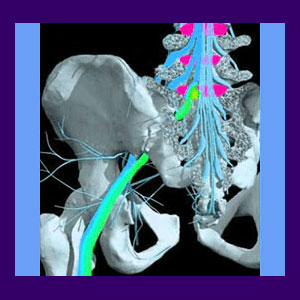
The real sciatica facts are generally not known to many people who suffer with radicular pain conditions. Unfortunately, they do not seem to be known to some of the doctors and chiropractors who treat the symptoms either.
Sciatica is one of the most common symptomatic expressions of lower back pain and related lower body neurological effects. Although usually blamed on a structural abnormality in the lumbar spine, many sciatic nerve complaints can be caused by spinal stenosis issues anywhere in the central canal.
Sciatica can also be sourced by nerve damage, scar tissue, muscular constriction, sacroiliac issues, disease processes and regional ischemia. There is certainly a whole lot more to lower body radiculopathy than there first appears to be.
The scope of this article will examine some of the myths of sciatic nerve symptoms and balance them out with some objective facts of sciatica.
Objective Sciatica Facts
Sciatica has a reputation as a chronic and persistent back pain problem. The syndrome affects every patient differently and can be blamed on a wide variety of spinal sources. Herniated discs and degenerative disc disease are perhaps the most common diagnoses used to explain sciatica. However, arthritis in the spine is also a prime player in the medical diagnostic industry. Additionally, so called pseudosciatica pain conditions are sometimes diagnosed when a spinal source can not be located. The most common of these pseudosciatica causes include sacroiliac joint pain and piriformis syndrome.
Despite the epidemic incidence of these structural conditions being blamed for creating sciatic nerve pain, one of the more common actual causations is oxygen deprivation of the sciatic nerve and surrounding peripheral nerves in the lower back, buttocks, legs and feet.
Proving Sciatica Facts
Matching the clinical symptomology against the suspected diagnosis often uncovers discrepancies which rule out the theorized anatomical source as the actual reason for the sciatica pain. For example, a herniated disc at L5/S1 might be diagnosed as compressing a nerve root (pinched nerve), due to a right side bulge. Foraminal stenosis is the diagnosis. However, the patient is experiencing pain in both legs, even though the left side is unaffected by the bulging disc structure. This lack of correlation is definitive evidence that something is flawed in the causative theory of pain mechanics.
Spinal arthritis is often targeted for blame when osteophytes are discovered in or around the facet joints or foraminal openings. However, once again, these structures are rarely responsible for the actual symptoms experienced by the patient. In most cases, the foramen will remain patent and allow plenty of room for the nerve roots to exit without compression.
Regardless of the diagnosed cause, many patients will have pain where none is appropriate. Each nerve root controls sensory messages for particular and defined regions of the lower body. A patient diagnosed with pain due to S1 compression will often show the expected symptomology, but will very typically also have symptoms in areas not related at all to S1. This is so common and rarely caught by non-neurologist diagnosticians.
These facts being said, nerve conduction evaluation will still often demonstrate particular nerve roots to be involved in the pain syndrome, despite a lack of evidence indicating structural compression. In these cases, damage may exist in the sciatic nerve itself or there may be a nonstructural process, like ischemia, enacting the symptoms all along.
Sciatica Myth or Fact
Sciatica is most often a variable process which produces an ever-changing range of pain and related symptoms in one or both legs. Patients who experience this type of condition will have a difficult time accurately connecting their symptoms to a single spinal causation. Ischemia is far more logical, since it is a regional process which can create a full range of uncomfortable sensations in the nerves and muscles on the entire lower body.
Knowledge therapy is a good choice of treatment for patients who have not found relief from more traditional medical modalities and suspect oxygen deprivation may be the true reason for their suffering. This is the exact same treatment I used to cure my own chronic sciatica and lower back misery a few years back.
For patients with verified anatomically-induced sciatic nerve pain, consider spinal decompression as a good option for some select causative conditions. This noninvasive therapy is very effective for many types of back pain and is certainly a better and safer bet than back surgery.
As a final thought on sciatica facts, I always recommend that patients who are diagnosed with any neuralgia syndrome change their care provider to a neurologist. These physicians specialize in nerve-related pain conditions and offer the best hope for accurate diagnosis and therefore, eventual effective treatment.





